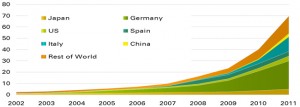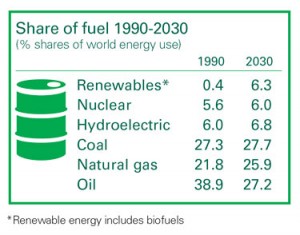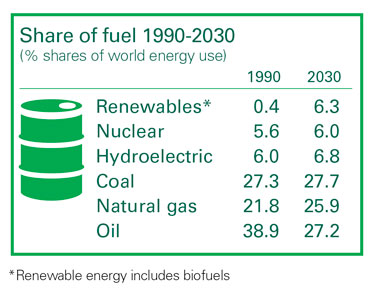If you are not following the energy industry mix closely then you probably are unaware of just how much new solar capacity has come online in the last decade, in fact, in the last year. That increase is quite dramatic.
No less than BP, the company that brought us the Deepwater Horizon disastrous spill in the Gulf of Mexico, is the bearer of better tidings for those who see solar energy and other renewables as the principal source of energy in our future.
From the BP Statistical Review of World Energy, published just last month, we have the following statistics:
- Growth in world energy consumption increased by 2.5% from 2010 to 2011
- Energy consumption declined by 0.8% in the Developed World
- Energy consumption grew by 5.3% in the Developing World
- Oil remained predominant although representing a declining share in global energy consumed at 33.1%
- Natural gas consumption grew by 2.2% while production grew by 3.1%
- Coal consumption grew by 5.4% accounting for 30.3% of global energy consumed
- Hydro electricity grew by 1.6%
- Nuclear power declined by 4.3%
- Biofuels grew by 0.7%
- Wind energy grew by 25.8%
- Solar energy grew by 86.3%
The Growth of Solar
Much of the growth in solar came from new capacity coming online in Germany and Italy. Those two countries accounted for 57.1% of the total new global capacity growth.
Today the top four solar power countries are:
- Germany at 24.8 Gigawatts
- Italy at 12.8 Gigawatts
- Japan at 4.9 Gigawatts
- China at 2.2 Gigawatts
As spectacular as these growth results are, solar’s share of global energy capacity stands at 6.5% in 2011, a ten-fold increase in capacity in the last five years and amounting to 70 Gigawatts.

What About Renewables in General?
For renewables in general, defined as energy from biofuels, geothermal sources, solar, wind and tide, the trend is increasing investment by governments and utilities as new technology comes on stream, creating better efficiencies and reliability.
Renewables continue to grow at a double digit growth rate annually over the last decade representing 10% of the total world energy growth in generation capacity. From eight countries in 2010 to fourteen in 2011, renewable sources now represent more than 10% of total generation capacity.
BP’s Forecast for 2030
BP sees renewables continuing to grow as overall energy consumption increases globally with almost all of it occurring in the Developing World. In its crystal ball calculations BP expects renewables, nuclear and hydroelectricity to contribute to 34% of the growth in global energy consumption, displacing coal and oil. At the same time its sees natural gas becoming the predominant energy fuel source achieving 31% of global energy growth and 25.9% of total world energy usage. At the same time BP predicts that renewables will increase by 1,575% in their share of world energy consumption with Europe in the lead generating 26% of its total electricity capacity through wind, solar, geothermal, tide and biomass.
One important thing to note: the BP forecasts for 2030 don’t talk about improvements to storage technologies and the implication this may have for renewable power. Nor does BP consider new technologies such as fusion, or fission-fusion hybrid, or hydrogen as energy sources. So we should take the BP projections and recognize their limitations.










